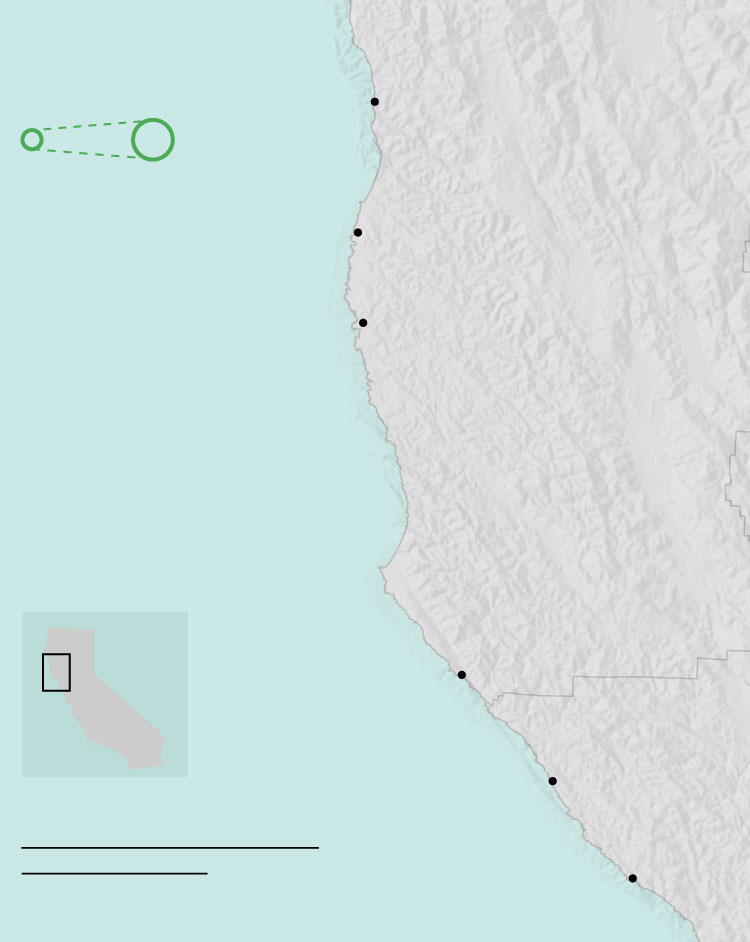Northern California's kelp forests have disappeared since 2008
Warming oceans have shrunk kelp forests, which support marine ecosystems, by over 99% near Sonoma and Mendocino counties
By Ilena Peng
Northern California has lost over 99% of its kelp forests in just over a decade, according to research from a team at the University of California.
Using satellite imagery, the researchers detected over 3.5 million square meters of kelp in 2008 along the coastline bordering Mendocino and Sonoma counties. By 2019, that number dropped to fewer than 11,000 square meters.
California’s kelp forests, sometimes referred to as the Sequoias of the Sea, are the backbone of a healthy ocean ecosystem. The waving fronds sustain small critters like snails, crabs, sea urchins and abalone, which in turn feed otters and other larger animals. But as climate change has contributed to warming waters, the forest has started to disappear.
"Imagine you were walking in the forest on your favorite trail, surrounded by tall beautiful trees, singing birds, flowers, animals, etc," said Meredith McPherson, the lead author and a postdoctoral researcher at University of Massachusetts Boston.
"Then imagine that suddenly one day you went back for a hike and that forests had disappeared. Completely replaced by nothing other than dirt and maybe some weeds. Imagine that it stretches for hundreds and hundreds of miles. That is what has happened to the kelp forests in northern California."

2016
2019
2008
Square meters of kelp
Westport
200
900
Fort Bragg
Mendocino
MENDOCINO COUNTY
Anchor Bay
SONOMA
COUNTY
Stewarts Point
30 mi
Fort Ross
30 km

2016
2019
2008
Square meters of kelp
Westport
200
900
Fort Bragg
Mendocino
MENDOCINO COUNTY
Anchor Bay
SONOMA
COUNTY
30 mi
30 km

2016
2019
2008
Square meters of kelp
Westport
200
900
Fort Bragg
Mendocino
MENDOCINO
COUNTY
Anchor Bay
SONOMA
COUNTY
30 mi
30 km
The density of kelp canopy does historically fluctuate and restore itself according to ocean conditions, but the current "scale and magnitude of this kelp loss was unprecedented," said Tristin McHugh, the kelp project director for The Nature Conservancy's California Oceans Program.
"We haven't seen a loss like this before, so we're still trying to understand how quickly an ecosystem can possibly rebound," McHugh said.
A combination of stressors led to the kelp canopy's decline during these years. El Niño and a marine blob led to warming waters that kelp has difficulty surviving in. Purple sea urchins, which feed on kelp, have been eating any of the kelp that regrows. The urchin’s populations have been growing unchecked since the sea star population that feeds on them has dropped as a result of sea star wasting disease.
Ali Bouzari, a culinary scientist and diver, said diving in the coast alongisde Sonoma and Mendocino coasts used to be like going "through a cornfield of kelp stalks." As the water warmed and kelp died, the landscape became filled by urchin barrens — vast areas covered only by purple sea urchins — which can sometimes exist for decades, as has occurred in some areas of Norway
"It was just empty water moving around above a floor that was wall to wall, carpet of sea urchins," he said.
Bouzari is a co-founder of Pilot R&D, a company that helps restaurants and food companies create new products. Since Bouzari began diving and collecting purple sea urchins in the Sonoma-Mendocino coast in 2015, he has been advocating for the urchins to become more popular in mainstream cuisine.
"Every couple of years, there's a story about how we've caused some ecological nightmare by becoming obsessed with a food and eating it to the point of being problematic," Bouzari said. "It seemed just an interesting concept. What if we could get people to be so obsessed with purple urchins that you would have a reversal of this issue?"
Though the purple urchins aren't as large as the red ones commonly seen in Japanese sushi restaurants, he said they work well when used in sauces, spreads or marinades. Other companies, like Urchinomics, have been harvesting and feeding the purple urchins so they're big enough to be used for uni at sushi restaurants.
Interest in purple sea urchins is high because of low red sea urchin demand, said Denise MacDonald, who leads the company’s global branding team. MacDonald added that restaurants outside of the sushi realm have also been looking to incorporate sea urchins into their menus.
"We’re beyond sustainable," MacDonald said. "The more you eat, the more you help us address the problem."
The company has commercial facilities that are already operating or in development in California, Canada, Japan and Norway.
In addition to limiting the purple sea urchin population that consumes kelp, the Nature Conservancy is also considering options for enhancing kelp forests, like adding kelp spores into the ecosystem, McHugh said. And the ocean has recently cooled, giving Northern California’s kelp a better chance of survival.
"In those years of 2014 to 2019 when the water was so, so warm that nothing could grow, you could go out diving and see virtually zero kelp at almost all of our long term monitoring sites," McHugh said. "That was alarming. But as soon as we started to see the ocean cool in 2020 — and it has been cool since — it started allowing a chance for kelp to actually grow."
Data and code are available on GitHub.